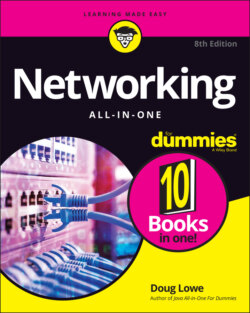Читать книгу Networking All-in-One For Dummies - Lowe Doug, Doug Lowe - Страница 158
Introducing IP Addresses
ОглавлениеAn IP address is a number that uniquely identifies every host on an IP network. IP addresses operate at the network layer of the TCP/IP protocol stack, so they are independent of lower-level data link layer MAC addresses, such as Ethernet MAC addresses.
IP addresses are 32-bit binary numbers, which means that theoretically, a maximum of something in the neighborhood of 4 billion unique host addresses can exist throughout the Internet. You’d think that would be enough, but TCP/IP places certain restrictions on how IP addresses are allocated. These restrictions severely limit the total number of usable IP addresses. Many experts predict that we will run out of IP addresses soon. However, new techniques for working with IP addresses have helped to alleviate this problem, and a standard for 128-bit IP addresses has been adopted, though it still is not yet in widespread use.
